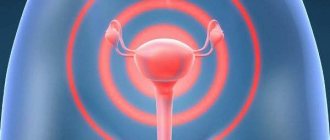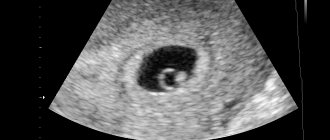What is a vaginal ultrasound?
Vaginal (transvaginal) ultrasound examination of the pelvis is carried out by inserting a special device equipped with a sensor into the vagina.
The device is a rod with a handle, which is made of plastic, about 10-12 centimeters long and up to three centimeters in diameter. A special groove may be built into it to insert a needle to take biopsy material.
The examination allows you to determine the presence of pathologies, neoplasms or diseases in the following female genital organs:
- Uterus
- Fallopian tubes
- Ovaries
- Cervix
It is considered the most effective for studying these parts of the reproductive system, as it allows one to identify various health problems of the patient in the early stages. A pelvic ultrasound with a sensor can show the presence of abnormalities even at a time when other studies do not show any problem areas.
What is transvaginal ultrasound?
Transvaginal ultrasound (TVUS) is an ultrasound examination performed with a special probe through the vagina. This technique allows you to more accurately and in detail display on the monitor an image of the uterus with the embryo developing in it, the cervix and ovaries. When using a vaginal sensor, pregnancy will be visible much earlier than with a conventional screening test. Thanks to good visualization, this technique is one of the main ones for diagnosing the fetus and timely detection of its possible abnormalities.
How is the procedure done?
The study is organized as follows:
- The patient should remove clothing from the lower part of the body (from the waist down)
- She sits on a special couch in the same way as during a regular gynecological examination.
- The doctor prepares the sensor: puts an individual condom on it, lubricates it with a special gel for the procedure
- The physician then inserts the device shallowly into the patient’s vagina.
- To get a complete picture of the state of the organs, he can move the sensor from side to side
- All data is recorded and processed by a doctor
The gel is necessary to facilitate the penetration of the sensor (and thereby reduce the likelihood of negative sensations) and enhance the ultrasonic effect by increasing conductivity.
This type of examination lasts no more than 10 minutes. It is painless and gives the most complete picture even in cases where an abdominal ultrasound shows nothing or cannot be performed.
Stages of the procedure
The transvaginal ultrasound procedure follows the following plan:
- the woman completely removes all clothing below the waist;
- takes a horizontal position on the couch near the ultrasound machine, slightly spreads his legs and bends them at the knees;
- the doctor puts a condom on the transvaginal sensor and lubricates it with a special gel;
- the device is inserted into the woman’s vagina;
- to collect more complete information about the patient’s condition, the sensor can be slightly rotated and its position changed;
- all measurements and data are recorded.
After completing the procedure, the woman removes the remaining gel using wet wipes and gets dressed. At this time, the doctor issues a written report.
When is a pelvic ultrasound with a sensor necessary?
There are symptoms in which the doctor must refer the patient for a transvaginal examination:
- Pain in the lower abdomen (not related to the menstrual cycle)
- Suspicion of the presence of neoplasms
- Periods of menstrual bleeding that are too short, too long or absent
- Impossibility of pregnancy
- Bloody discharge that is not menstruation
- Presence of fallopian tube obstruction
- Nausea, vomiting and weakness with bloody discharge from the vagina
Doctors recommend using this type of examination for preventive purposes, since not every ailment may have symptoms at an early stage, just as pregnancy in the first trimester may not manifest itself with classic symptoms (nausea, etc.).
In this case, vaginal ultrasound is used for:
- Diagnosis of infertility
- The need to determine the presence of changes in the size of the ovaries and uterus
- Diagnosis of pregnancy
- Pregnancy monitoring (first trimester only)
- General monitoring of the condition of the uterus, fallopian tubes and ovaries
A pelvic ultrasound can be performed simultaneously with two sensors. In this case, an abdominal ultrasound examination is performed first, and then a transvaginal one. The use of two types of analysis at once is necessary to identify disorders in the high-lying pelvic organs.
Late vaginal ultrasound
As we just noted, transvaginal ultrasound is performed in early pregnancy. After 12 weeks of pregnancy, the use of vaginal ultrasound is not so common, but there are still a number of indications for such a study:
- assessment of the condition of the cervix - its length and ability to retain the amniotic sac;
- diagnosis of abnormalities in the location of the placenta - placenta previa;
- assessment of the condition of the uterine scar if the pregnant woman had a cesarean section delivery.
What does a vaginal ultrasound show?
This examination allows you to evaluate the following parameters of the reproductive system organs:
- Dimensions of the uterus. In normal condition, it should be about seven centimeters in length, six in width and 4.2 in diameter. If it is significantly less or more, then this indicates the presence of pathology
- Echogenicity. The structure of the organs must be homogeneous, uniform, have clearly defined, clearly visible edges
- General picture of internal organs. The uterus should be slightly tilted forward. And the fallopian tubes may be slightly visible, but should not be clearly visible without the use of a contrast agent
Diagnosed diseases
Transvaginal ultrasound allows you to identify a number of diseases and problems in the reproductive system at an early stage. It allows you to detect:
- Fluid and pus in the uterus and fallopian tubes. The cause of their appearance may be infections, viruses, mechanical damage
- Endomentriosis is an excessive proliferation of cells in the inner layer of uterine tissue into other layers and organs. It can occur due to inflammatory processes, damage (surgery, abortion), the appearance of neoplasms, disruption of the endocrine system, too frequent use of certain medications and substances
- Myoma is a benign neoplasm in the tissues of the uterus or its cervix. May occur due to chronic diseases, frequent abortions, hormonal imbalances, constant stress, pathologies, excess weight, or with hereditary predisposition
- Cysts and polycystic ovaries are tumors filled with fluid. Occurs with endocrine disorders, chronic diseases of the genitourinary system
- Various polyps on the walls of the uterus are benign formations in the endometrium of the organ. They can reach several centimeters in diameter. Their appearance may be associated with polycystic disease, chronic diseases, mastopathy, fibroma
- Inflammation and enlargement of organs can occur due to both infection and injury.
- Hydatidiform mole - appears instead of a full-fledged embryo during the process of conception, filled with fluid. Occurs due to duplication of male chromosomes with the loss of female chromosomes, sometimes due to fertilization of an egg that does not contain a nucleus. This disease is rare
- Fetal development disorders during pregnancy
- Defects and pathologies in the development of the fallopian tubes: obstruction, spiral-shaped or too long tubes, blind passages, duplication of organs
- Ectopic pregnancy occurs when an egg implants outside the uterine tissue after fertilization. Occurs due to blockage of the fallopian tubes, congenital anomalies in them, as well as after an inflammatory process, abortion
- Cancer is a malignant tumor in various organs:
- Uterus
- Ovarian
- Cervix
Stages of preparation for the study
To conduct a pelvic ultrasound with a sensor, no special preparation is required, but there are several mandatory requirements:
- Unlike an abdominal examination, with a transvaginal analysis the patient should not drink liquid one to two hours before the examination.
- If she emptied her bladder more than an hour before the test, she needs to do it once immediately before the procedure
- With increased flatulence, the patient needs a drug that will help normalize the processes of gas formation in the gastrointestinal tract. She can consult with her doctor about the choice of medication
Doctors also recommend using such a study on certain days of the cycle, depending on which organ needs to be diagnosed and for what purpose:
- In the case of a preventive examination, it should be done in the first days after the end of menstruation
- If there is a suspicion of an increase in the endometrial layer in the uterus, then in the second half of the cycle
- When it is necessary to monitor the development of a disease or the progress of treatment, the study can be carried out several times in one cycle, at different stages.
- An ultrasound is performed urgently if there is bleeding that is not menstrual, regardless of the day of the cycle
It is important to remember to maintain personal hygiene before the examination, use wet and other wipes.
If you plan to conduct a pelvic ultrasound with two sensors, then you should pay attention to preparing for the abdominal examination.
This includes:
- Follow a diet for at least three days before the test to reduce the likelihood of symptoms of flatulence and bloating
- The last meal should be completed by six o'clock in the evening on the eve of the test.
- It is recommended to do an enema after eating
- If there is still a risk of flatulence, you need to use special medications that reduce gas formation
- An hour before the test, drink at least 400 ml of water
The diet involves excluding a number of foods from the diet:
- Sweets
- Flour (bread, cookies, etc.)
- Legumes
- Cabbage
- Milk and dairy products
- Vegetables and fruits that have not undergone heat treatment
- Coffee and strong tea
- Carbonated drinks
- Fast food
- Fatty foods (meat, fish, oils)
You can eat porridge cooked in water, lean boiled beef, poultry and fish, and hard cheeses. It is recommended to drink lightly brewed, slightly sweetened tea.
It must be remembered that since you need to drink liquid before the abdominal examination, you must empty your bladder before the transvaginal analysis.
How to prepare
To obtain reliable results, it is necessary to prepare in advance for the transvaginal ultrasound examination procedure.
- 3 days before the procedure, exclude from the diet foods that increase gas formation.
- On the eve of the study, take a prophylactic dose of drugs against flatulence and increased gas formation.
- There is no need to drink water before the procedure; excess fluid in the bladder can only interfere.
- Before starting the procedure, you need to go to the toilet.
In cases of urgent need, this diagnostic method can be carried out without prior preparation, but the accuracy of the results obtained may be lower.
Contraindications
Vaginal ultrasound examination has a small number of contraindications:
- It is never performed if the patient is a virgin, so as not to violate the integrity of the hymen. In this case, such a patient can undergo a transrectal examination, in which a sensor is inserted into the rectum
- The study is prohibited from being carried out in the second or third trimester of pregnancy, because it may provoke premature contractions or uterine contractions before the expected due date.
- This test is not used if the patient is allergic to latex
- If the patient has epilepsy, since the examination requires that she lie still











